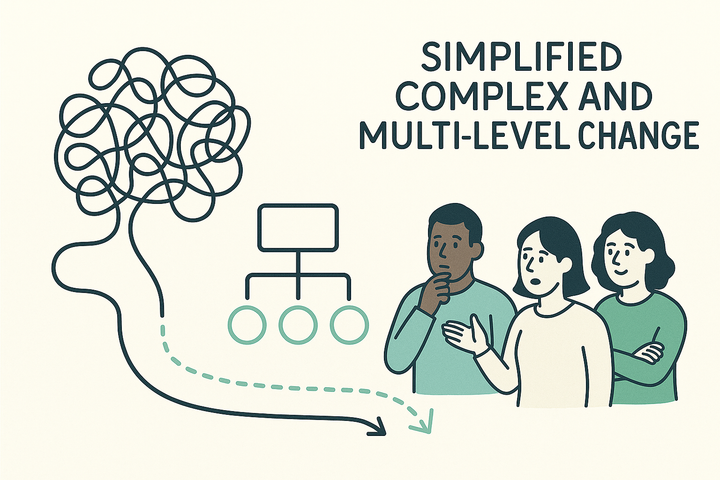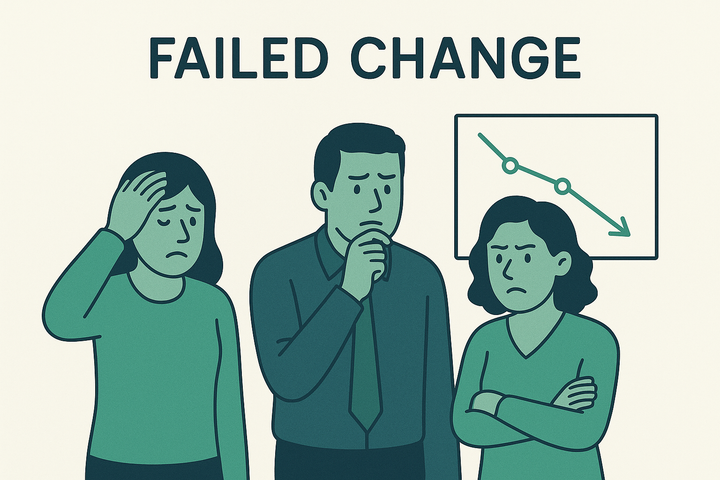The Art of the Backstitch – Why You Need to Return and Return Again to Your Narrative
Change communication isn't a straight line. This article explores how returning to your narrative — the way a backstitch reinforces a seam — is the key to lasting understanding, alignment and momentum.

Change is not a straight line
One of the biggest mistakes in change communication is thinking it’s a one-time job.
You write the message, you launch the comms, you deliver the deck. Job done.
Except... it isn’t.
Because change doesn’t land just because you’ve announced it. It lands when people understand it. When they’ve heard the story more than once. When they’ve connected the dots between what you said last month and what they’re being asked to do this week.
That’s why we use the metaphor of the backstitch.
In sewing, a backstitch is used to reinforce a seam. You move forward, then back, then forward again — securing the thread, making the fabric stronger. It’s not about speed. It’s about strength. About permanence. About holding things in place even under pressure.
In change communication, the backstitch is how you make your narrative stick.
What does backstitching look like in change comms?
It means returning to the narrative. Not just once. Not just at the start. But over and over — through meetings, updates, decisions, and conversations.
Done well, backstitching shows up like this:
- Senior leaders refer back to the core story in every all-staff briefing
- Project teams use the narrative to frame decisions and updates
- Managers link operational updates to the bigger picture
- Comms teams reinforce key themes across different channels, in different voices
It’s not repetition for the sake of it. It’s reinforcement. A deliberate return that makes the story stronger each time it’s told.
Why repetition builds trust
One of the great myths of leadership is that if you’ve said something once, people have heard it.
They haven’t.
People are busy. Distracted. Juggling priorities. Dealing with their own version of the change.
You may be living and breathing this programme. But for them? Your “big message” was probably skimmed over lunch or half-heard in a team meeting they were multitasking through.
Repetition matters because:
- Familiarity breeds confidence
The more people hear a story, the more comfortable they become with it. - Consistency signals commitment
If leaders keep returning to the same narrative, it shows they believe in it. - Reinforcement strengthens meaning
With each retelling, the story gathers nuance, depth and emotional weight. - Repetition aids recognition
When people hear the same language, framing and themes, they start to internalise the message.
It’s not enough to “launch the narrative.” You need to embed it. And embedding takes rhythm.
You might also like:
- Creating a Change Narrative
- Using Metaphors in Change Narratives
- The Art of the Backstitch – Why You Need to Return and Return Again to Your Narrative
- Change and Transformation Visions – Painting the Future State
- The Four Types of Organisational Change and How to Communicate Them
Repetition with variation
The backstitch is not mechanical. It’s creative. Returning doesn’t mean parroting.
You can tell the same story in different ways:
- With data and results
- Through leader storytelling
- Via staff voices and lived experience
- In visuals and metaphors
- As case studies, updates or reflective moments
The message is the same. The framing evolves. That’s what keeps it alive.
Mistaking familiarity for saturation
One of the easiest traps for leaders is assuming: “We’ve already said that.”
Yes. You have.
But the people who matter most? Your managers, your frontline teams, your external stakeholders? They’re hearing it for the first or second time — and they need more.
Just because a message is familiar to you doesn’t mean it’s saturated in the system.
This is especially true in large organisations or fast-moving environments. Information gets diluted, delayed or dropped. Without deliberate reinforcement, the narrative fragments.
If you want your story to hold, you have to backstitch it into the fabric of the organisation.
How to build a backstitch rhythm
This is where narrative becomes operational. You need a rhythm, not just a message.
Here’s how to build one:
1. Design a communication cadence
Establish a regular pattern for reinforcing the narrative. That could mean monthly themes, structured check-ins, or quarterly narrative reviews.
2. Equip leaders and managers
Don’t just tell them what to say. Help them anchor their updates in the core story. Provide narrative hooks, examples and shared language.
3. Make the narrative modular
Break it into components that can be reused and recombined. A good story has chapters, not just a headline.
4. Stitch it into your systems
Use it in performance frameworks, onboarding, team goals, feedback sessions, project launches and recognition schemes. The more places it shows up, the stronger it becomes.
5. Check the seams
Monitor for slippage. Ask: are leaders staying on message? Are teams repeating the language? Are decisions still tethered to the core story?
Signs your narrative is unravelling
Even strong narratives can come loose. Watch for:
- People asking foundational “why” questions long after launch
- Teams reporting confusion or contradictory messages
- Leaders drifting off-script or softening commitment
- Managers expressing discomfort with the story they’re asked to deliver
- Communication that feels scattered, inconsistent or reactive
These are signs that your change story has not been stitched back in. The original message may have been clear — but it hasn’t been secured.
Final thought
The backstitch isn’t glamorous. It’s not a one-off keynote or a splashy campaign.
It’s the patient, deliberate act of returning to the story. Strengthening the thread. Holding the shape under pressure.
And in change communication, that’s where the real work is.
Because change is not a single announcement. It’s a sustained narrative. And the organisations who land it well are the ones who understand: if you want it to hold, you have to stitch it in — and then stitch it in again.
Not sure your narrative is holding?
Start with the Sound & Signal Review — our no-nonsense diagnostic that shows you what’s landing, what’s missing, and where your message is getting lost in translation.
Already mid-flight and losing traction? The Rapid Action Accelerator is built to get leaders aligned, comms back on track, and momentum moving in the right direction — fast.



